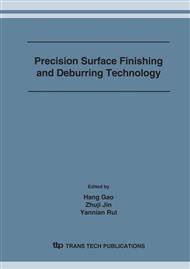p.309
p.315
p.321
p.325
p.333
p.337
p.343
p.349
p.355
Study on Hardness Depth Variation of Different Grinding Zone in Grind-Hardening
Abstract:
The experiments are performed to study the hardness layer depth at work piece different surface zone in grinding. The result is that hardness layer depth is various at work piece different surface zone. The hardness layer depth is thinner at cutting-in grinding zone, deeper at middle grinding zone and deepest at cutting-off grinding zone. In order to analyze the cause of hardness depth variation, the grinding temperature field is simulated by means of finite element method. From the temperature field and heat flux simulation, the cause of the hardness depth variation is that the grinding heat flux is variable at different grinding zone along the work piece surface in grind-hardening. At cutting-in zone, most of grinding heat flows into the front-below work piece part inverse to table speed, the depth that temperature of surface layer higher than austenite temperature is thin and there is slim martensite transformation layer. At middle zone, the temperature of surface layer is higher than austenite temperature because of grinding heat accumulated in the surface layer, and martensite transformation takes place after cooling. At cutting-off zone, most of grinding heat flows into the below work piece part because of work piece boundary, and hardness depth is deeper than that at middle zone.
Info:
Periodical:
Pages:
333-336
Citation:
Online since:
September 2007
Authors:
Price:
Сopyright:
© 2007 Trans Tech Publications Ltd. All Rights Reserved
Share:
Citation:


